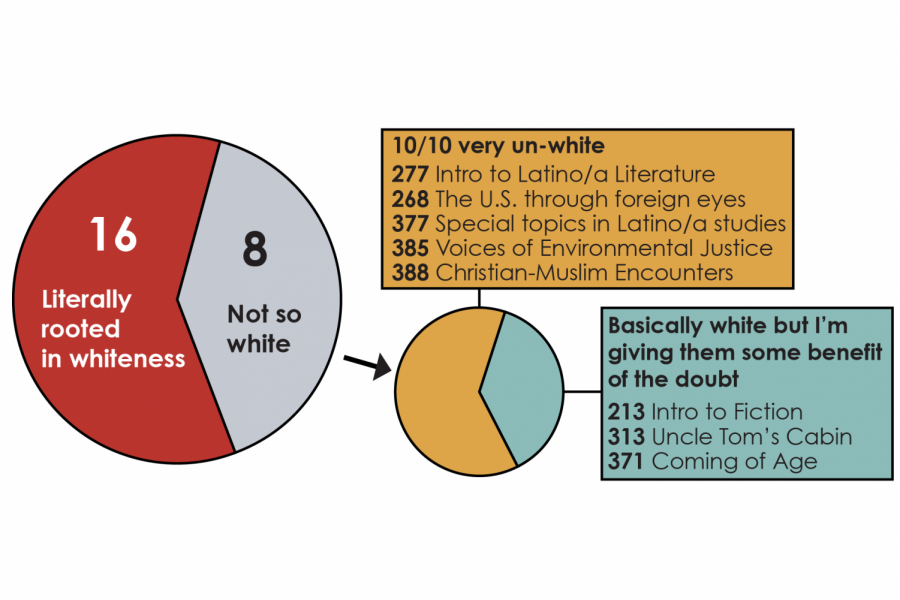Kim: We need more diverse voices in our English readings
November 16, 2017
Every course I take toward my English literature degree is an emotional roller coaster. It’s one I admit partially stems from my own obsession with having to get the most out of my college years, but I also believe it largely speaks to the nature of an English education.
I often treat quarterly registration like a sacred, week-long affair. Especially with only five quarters left on campus, I hope to maximize the cherished moments of sitting in a classroom and feeling the thrill of reading and discussing new material that turns me upside down. But the reason I have such a love-hate relationship with my major is that I don’t feel that thrill as often as I know I could. Rather, pursuing the degree has made me extremely critical of its homogeneous curriculum, disproportionately dominated by white (I might as well give you the whole package: European, male, Christian…) writers with minimal opportunity to read varied voices.
I don’t write this to imply that the widely accepted literary canon and intellectual stimulation are mutually exclusive. I’ve had my fair share of “thrill” moments reading what one may call stereotypical white English writers, under some of the most insightful professors I’ve had the pleasure of knowing. I will forever love “Little Women” and have been eyeing Austen and Faulkner courses for more than a year now. But there lies a certain joy in encountering something unlike anything you’ve known before, one that you certainly know if you’ve taken an ethnic studies course about your own lived experiences, or a history class that took you beyond the U.S. for the first time.
I took a look at the English department’s offerings for Winter Quarter 2018. It’s even more homogeneous than I expected. Excluding creative writing courses — they’re technically a different degree, and professors offer widely varying course readers not currently available online — there are a total of 24 English literature courses I have to choose from. And at least four of them would require me to read Walt Whitman again.
I say that somewhat jokingly, but in all seriousness, I’ve already read Whitman three times. In fact, I will be reading him again this winter for my required English 300 seminar. And though I’m stoked for the course and hold immense respect for my professor, I am concerned and disappointed by the range of options I have to fulfill my remaining requirements.
So I created a chart to reflect my headspace while going through course registration. Of course nothing is this rigid, and a course’s value is not reduced to a demographic breakdown of its readings, but these blatant discrepancies are disheartening to see before classes have even begun. (Keep in mind that this is only one quarter, which one professor informed me may be disproportionately worse due to faculty going on leave. Past years’ offerings are available here.)
I’ve categorized two-thirds of the Winter Quarter course offerings as fundamentally rooted in whiteness, meaning the same names you see throughout English syllabi all the time: Keats, Shelley, Shakespeare, Woolf. The list goes on. The other eight seem to offer more flexibility. But still, only five of those immediately sparked my interest as something entirely beyond what English students are used to, a step away from a standard literature education.
The English 213 Introduction to Fiction class will look at several of the “greatest and most influential novels.” Yet four of these — “Frankenstein,” “Jane Eyre,” “Mrs. Dalloway” and “Heart of Darkness” — are standard novels by 18th- and 19th-century European writers. That leaves “The Bluest Eye” the explicitly outlying, non-white text in a course intended to survey a genre as vast as fiction. Even coming from someone whose favorite book is “Jane Eyre,” this is eyebrow-raising: Clearly, even among the eight courses I highlight, I provide significant benefit of the doubt when it comes to diversity of learning.
And this is emblematic of the department itself. My experience in the required American Literary Traditions sequence was hugely formative, but could’ve benefitted from writers beyond Poe, Hawthorne and Melville. A whopping six of the 24 courses read Shakespeare. In fact, I may drop the major entirely because I’m struggling to finish the three required pre-1830 courses, and not a single one of the seven qualifying courses this winter — two of which are surveys of Shakespeare — allows me to venture beyond European literature.
I love English literature and I love my professors. And it’s only because of this love that I’m often disappointed by my experience. There is so much more the field has to offer, and it is my hope that our department continues expanding to reflect this richness. The aforementioned professor hit the nail on the head when he said, “no English department is going to stop teaching Chaucer or Shakespeare, nor should they, but … there are ways of engaging the literature that can make it resonate with important questions that students face today.” The best professors I’ve had are the ones who make textual encounters as dynamic as possible regardless of the core curriculum, and these micro attempts are just as important — if not more so — in shaping our studies than the macro, structural whiteness of English literature.
This column was updated Nov. 20 to include that Joseph Conrad’s “Heart of Darkness” is required reading in English 213.
Correction: A graph on a previous version of this column misstated the number of English literature courses to be offered in Winter Quarter 2018. Twenty-four English literature courses will be offered. The Daily regrets the error.
Yvonne Kim is a Medill junior. She can be contacted at [email protected]. If you would like to respond publicly to this column, send a Letter to the Editor to [email protected]. The views expressed in this piece do not necessarily reflect the views of all staff members at The Daily Northwestern.


